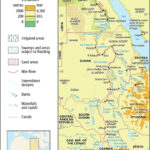Copenhagen, a city celebrated for its captivating blend of historical charm and contemporary design, stands as the heart of Denmark. But Where Is Copenhagen exactly? This guide will pinpoint the geographical coordinates of this Scandinavian gem and explore why its location has been pivotal to its rich history and modern vibrancy.
Nestled strategically in Northern Europe, Copenhagen graces the eastern coast of Zealand (Sjælland) and partially extends onto the island of Amager. This puts it squarely at the southern end of The Sound, known as Øresund in Danish, the strait that elegantly separates Denmark from Sweden. This prime positioning has been fundamental throughout Copenhagen’s evolution, transforming it from a modest village into a powerful capital and a significant European hub.
A Historical Tapestry Woven into its Location
Copenhagen’s story begins in a small 10th-century village, its coastal location naturally inviting settlement and trade. By 1167, Bishop Absalon of Roskilde, recognizing the strategic importance of the site, erected a castle on a coastal islet, fortifying the burgeoning town. This marked the beginning of Copenhagen’s ascent. Its advantageous location at The Sound, a crucial waterway for Baltic Sea trade, propelled its growth. In 1445, Copenhagen officially became Denmark’s capital, solidifying its central role in the kingdom.
Throughout history, Copenhagen’s location has placed it at the crossroads of conflict and progress. The Protestant Reformation’s turbulent years saw the city endure sacks and strife. Yet, the late 16th century ushered in an era of flourishing trade and urban expansion. Iconic structures like the Børsen (Stock Exchange), Holmens Church, Trinitatis Church with the Round Tower, and Rosenborg Castle emerged during this period, testaments to Copenhagen’s growing prominence. Besieged by Sweden from 1658-1660 and bombarded by the British in 1807, Copenhagen faced adversity, but each time, it rebuilt and expanded, incorporating surrounding districts after the removal of ramparts in 1856.
Landmarks and Locales: Navigating Copenhagen
The Rådhuspladsen, or Town Hall Square, serves as the vibrant heart of modern Copenhagen. From this central point, the Strøget, a historic and winding shopping street, leads towards Kongens Nytorv (King’s New Square), laid out in the 17th century and marking the former city center. Kongens Nytorv is framed by significant buildings like the Thott Palace, Charlottenborg Palace, and the Royal Theatre, each echoing Copenhagen’s rich cultural and historical tapestry.
Slotsholmen, or Castle Islet, is another key area, home to Christiansborg Palace, built upon the foundations of Bishop Absalon’s original castle. Today, Christiansborg Palace houses the Danish Parliament, the Supreme Court, and the Foreign Office, making it the center of Danish political power. Slotsholmen also boasts cultural treasures such as the Bertel Thorvaldsen Museum, the Royal Arsenal Museum, the state archives, and the Royal Library, including its modern extension, the Black Diamond, a striking waterfront structure.
Beyond these central areas, Copenhagen unfolds with diverse districts and attractions. Prinsens Palace, now the National Museum, the Church of Our Lady, and the University of Copenhagen, founded in 1479, are testaments to the city’s historical and intellectual heritage. The Tycho Brahe Planetarium, a modern landmark, honors the legacy of the famous astronomer. For leisure and recreation, Tivoli Gardens offers amusement and entertainment, while the Botanical Gardens provide a tranquil escape. No visit is complete without seeing the Little Mermaid statue at Langelinie Pier, a beloved symbol of Copenhagen inspired by Hans Christian Andersen’s fairy tale.
Christianshavn, the old quarter south of the harbor, features the 17th-century Church of Our Saviour, while to the west, Frederiksberg Park offers green space, a palace, and a zoo.
Copenhagen in the 21st Century: A Modern Metropolis
While Copenhagen was once a manufacturing powerhouse, its modern economy is now driven by services, trade, finance, and education. Efficient infrastructure, including electric commuter railways (S-baner), bus lines, and a modern subway system, ensures easy navigation. The Øresund Link, a combined tunnel and bridge system opened in 2000, connects Copenhagen to Malmö, Sweden, further integrating the region and boosting Copenhagen Airport at Kastrup as a major international gateway.
 The Little Mermaid statue in Copenhagen harbor, a famous landmark and symbol of the city
The Little Mermaid statue in Copenhagen harbor, a famous landmark and symbol of the city
Copenhagen’s location is not just a matter of geography; it is integral to its identity. Situated at the nexus of land and sea, history and modernity, Copenhagen continues to thrive as a dynamic capital city. Its position in Northern Europe, on the islands of Zealand and Amager, at the edge of The Sound, defines its past, present, and future as a key player on the European stage.
[

